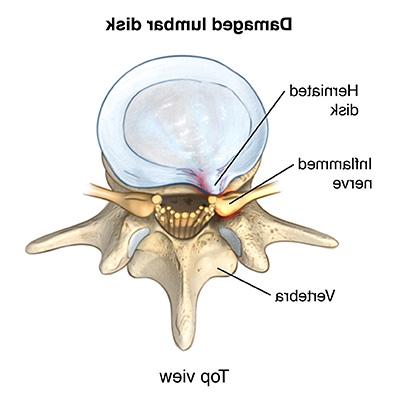神经根病
你需要知道的
- 神经根病 describes a range of symptoms produced by the pinching of a nerve root in the spinal column.
- The pinched nerve can occur at different areas along the spine (cervical, thoracic or lumbar).
- Symptoms of radiculopathy vary by location but frequently include pain, 弱点, 麻木和刺痛.
- A common cause of radiculopathy is narrowing of the space where nerve roots exit the spine, 哪些是狭窄的结果, 骨刺, 椎间盘突出或其他情况.
- 神经根病 symptoms can often be managed with nonsurgical treatments, but minimally invasive surgery can also help some patients.
什么是神经根病?
你的脊椎是由许多叫做椎骨的骨头组成的, and your spinal cord runs through a canal in the center of these bones. Nerve roots split from the cord and travel between the vertebrae into various areas of your body. When these nerve roots become pinched or damaged, the resulting symptoms are called radiculopathy.
神经根病的类型
神经根病 can have different symptoms and different names depending on where in the spine it occurs.
腰椎神经根病
当神经根病发生在下背部时, 它被称为腰椎神经根病, 也被称为 坐骨神经痛 because nerve roots that make up the sciatic nerve are often involved. The lower back is the area most frequently affected by radiculopathy.
神经根病的预防
然而神经根病并不总是可以预防的, staying physically fit and maintaining a healthy weight may reduce your risk of radiculopathy. 使用最佳的坐姿练习, 参加体育运动, exercising or lifting heavy objects is also important for preventing injuries.
颈神经根病
Cervical radiculopathy describes a compressed nerve root in the neck (cervical spine). Because the nerve roots in this area of the spine primarily control sensations in your 武器 and hands, 这是最有可能出现症状的地方.
胸神经根病
Thoracic radiculopathy refers to a compressed nerve root in the thoracic area of the spine, 哪个是你的上背部. 这是神经根病最不常见的部位. 症状通常遵循皮节分布, and can cause pain and numbness that wraps around to the front of your body.
神经根病的症状
当神经根受到压迫时,它就会发炎. This results in several unpleasant symptoms that may include:
-
背部剧痛, 武器, 腿部或肩部可能因某些活动而恶化, 即使是像咳嗽或打喷嚏这样简单的事情
-
四肢无力:手臂或腿的无力或丧失反射能力
-
麻木:皮肤麻木, “坐立不安,” or other abnormal sensations (paresthesia) in the 武器 or legs
Your specific symptoms will depend on where in the spine the nerve root is pinched. 然而, it’s also possible that you don’t experience any symptoms or you go through periodic flare-ups of symptoms.
神经根病的病因
神经根病 is typically caused by changes in the tissues surrounding the nerve roots. These tissues include bones of the spinal vertebrae, tendons and intervertebral discs. 当这些组织移动或改变大小时, they may narrow the spaces where the nerve roots travel inside the spine or exit the spine; these openings are called foramina. The narrowing of foramina is known as foraminal stenosis, which is very similar to 脊髓狭窄 这会影响脊髓.
在大多数情况下, foraminal stenosis is caused by gradual degeneration of the spine that happens as you age. 但也可能是脊椎损伤的结果.
椎间盘髓光盘
One common cause of foraminal stenosis and radiculopathy is a bulging or 椎间盘突出. 椎间盘在你的椎骨之间起到缓冲作用. On occasion, these discs slip out of place or become damaged and press on nerves. This problem is most likely to occur in your lower back, but it can also affect your neck.

骨刺
Another possible cause of radiculopathy that may lead to narrowing of foramina is 骨刺 — areas of extra bone growth. Bone spurs can form in the spine due to inflammation from osteoarthritis, 创伤或其他退行性疾病.
其他原因
Thickening (ossification) of the spinal ligaments may also lead to narrowing of the space around the nerve roots and subsequent nerve compression. Less common causes of radiculopathy include spinal infections and various cancerous and noncancerous growths in the spine that may press against the nerve roots.
神经根病和脊髓病
有时,神经根病可伴有 脊髓病 -脊髓本身的压迫. Herniated or bulging discs can sometimes press on the spinal cord and on the nerve roots. 当脊髓受累时, 症状可能更严重, 包括协调性差, 行走困难和瘫痪.
神经根病与神经病变
神经根病的症状可能与神经根病的症状重叠 周围神经病变, making it difficult to pinpoint the source of the problem. Peripheral neuropathy is the damage of the peripheral nervous system, such as 腕管综合症 这涉及到手腕上的神经. 神经根病是指神经根受压, 有时也会产生疼痛, 手腕和手无力和麻木. 向脊柱专家咨询准确的诊断.
神经根病诊断
Your doctor may take several steps to diagnose radiculopathy:
-
A physical exam and physical tests may be used to check your muscle strength and reflexes. If you have pain with certain movements, this may help your doctor identify the affected nerve root.
-
成像测试, 比如x光, CT扫描或MRI扫描, 用来更好地看到问题区域的结构.
-
神经传导研究, 还有肌电图, can also be used to help pinpoint whether the problem is neurological or muscular.
神经根病治疗
神经根病 treatment will depend on the location and the cause of the condition as well as many other factors. Nonsurgical treatment is typically recommended first and may include:
-
药物, 比如非甾体类抗炎药, 阿片类药物或肌肉松弛剂, 控制症状
-
Weight loss strategies to reduce pressure on the problem area
-
物理治疗 增强肌肉,防止进一步损伤
-
类固醇注射 消炎止痛
Some people may need more advanced treatments, such as surgery. Surgery is typically used to reduce the pressure on the nerve root by widening the space where the nerve roots exit the spine. This may involve removing all or parts of a disc and/or vertebrae. 颈椎后椎间孔切开术是其中之一 微创脊柱外科 可用选项.






